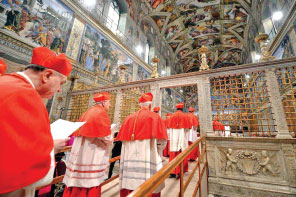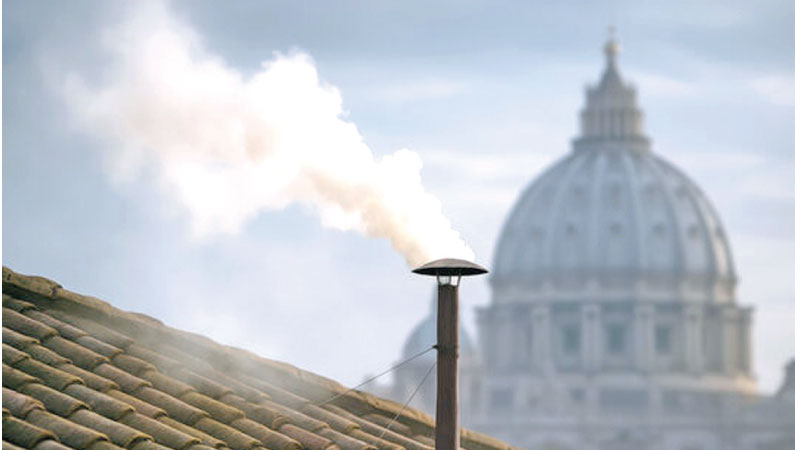 A Conclave is about to take place, the date is set for May 7, 2025, where white smoke will herald to the world a new Pope. Pope Francis was truly an unprecedented figure in the history of the Catholic Church, as the first Jesuit Pope, the first from the Americas, and the first non-European in over a millennium, his election broke centuries of tradition. His choice of name—honouring St. Francis of Assisi—signaled a papacy embedded in humility, compassion, and care for the poor and the planet.
A Conclave is about to take place, the date is set for May 7, 2025, where white smoke will herald to the world a new Pope. Pope Francis was truly an unprecedented figure in the history of the Catholic Church, as the first Jesuit Pope, the first from the Americas, and the first non-European in over a millennium, his election broke centuries of tradition. His choice of name—honouring St. Francis of Assisi—signaled a papacy embedded in humility, compassion, and care for the poor and the planet.
Known for his modest lifestyle and emphasis on mercy over judgment, Pope Francis has reoriented the Church’s focus towards social justice, environmental stewardship, and inclusivity, demanding both internal and external norms with calm but radical resolve. Now that the world has bid adieu to their beloved “papa,” their attention will be focused on the Conclave, a fascinatingly secretive ritual that takes place within the sanctums of the Sistine Chapel, beneath a canopy of Michelangelo’s masterpieces.
History
In the initial centuries of Christianity, Popes were elected by the clergy and laity of Rome, often influenced by imperial or noble families. These early elections were far removed from the formalised process known today as the Conclave, and sometimes led to disputes and even multiple rivals appearing as claimants to the papal throne, known as the antipopes.
The modern concept of the Conclave all started in the 13th Century following the death of Pope Clement IV in 1268. The Cardinals unable to select the next Pope for over 3 years were ultimately locked inside the Palazzo dei Papi at Viterbo with its roof removed and given only bread and water to force a decision; this unprecedented pressure led to the election of Pope Gregory X and inspired lasting reform.
That first Conclave selected an archdeacon and not an ordained priest, who went on to become Pope Gregory X. The new Pope decreed that future changes to the headship of the Church must initiate with a Conclave, to avoid extended vacancies. The official establishment of the Conclave by Pope Gregory X was instituted in 1274 at the Second Council of Lyon.
Over the centuries, the Conclave process was refined and by the 15th century, voting took place inside the Sistine Chapel, and the method of burning ballots to produce black or white smoke became a tradition. Popes like Pius X (early 20th century) and John Paul II (late 20th century) introduced further reforms, including age restrictions for voting Cardinals (currently under 80 years old) and clearer procedures for handling deadlocks.
Secret Conclave
Funeral rites for the late Pope are held for nine days, as he is mourned and celebrated. Conclaves must begin within 15 to 20 days after a Pope dies or resigns. Upon the Pope’s death, the dean of the College of Cardinals calls the Cardinal electors to the Vatican; there are currently 135 of them. To join the Conclave, Cardinals must be under 80 years old.
Once the presiding Pope dies, the camerlengo, a Cardinal whose title translates to “chamberlain” is instantly entrusted with the duty of announcing the Pope’s demise and supervising the Holy See until a successor is selected. The present camerlengo is Cardinal Kevin Farrell, the first American to bear the position. Upon the Pope’s death, the dean of the College of Cardinals calls upon the Cardinal electors to the Vatican.
During the Conclave, the Cardinals live in the Domus Sanctae Marthae, a hotel-like structure next to St. Peter’s Basilica. This is where Pope Francis chose to live instead of the luxurious papal apartments of the Apostolic Palace. This residency is comparable to a three-star hotel.
The ceremonies are held in accordance with the rules and regulations the Popes have made throughout the many centuries, delineating their timeframe and responsibilities. However, the real allure of this election process comes from the obscurity and “total secrecy,” in which it takes place. All Cardinal electors will undertake a pledge of secrecy and solitude, under the possibility of excommunication.
“Some of the mystery comes from the closed nature of the Conclave itself,” said Gregg Gassman, the editor of the Pontifacts podcast, who is also a librarian. Once the Cardinals are gathered, the dean of the College of Cardinals presides over a mass. The group then walks together from the Pauline Chapel to the Sistine Chapel, singing hymns invoking the Holy Spirit.
At the Sistine Chapel, an oath of secrecy touching upon the Holy Gospels is recited in Latin and once the ritual is finished, the papal master of ceremonies announces in a dramatic fashion, Extra omnes! Commanding all those who don’t belong (other than the Cardinal electors) to vacate immediately.
Beyond the chapel, the renowned Papal Swiss Guards will guard the doors shut, while all forms of contact with the outside world will cease until the new Pope has been elected. The only form of communication with the outside world will be a signal of black or white smoke emanating from the Sistine Chapel, and all media channels from across the world will no doubt focus their attention on the infamous chimney. Black smoke signals that a decision is yet to be made while the white will indicate a new Pope has been chosen. All of the Conclaves from 1900’s were held at most within four days. Pope Francis was selected as Pope on the second day of the Conclave, following a triumphant vote.
Voting begins
Once the declaration has been made and the gates are sealed shut. Each Cardinal writes the name of their chosen candidate on a plain card bearing the Latin phrase: “Eligo in Summum Pontificem”—which means “I elect as Supreme Pontiff.”
Only one round of voting takes place the very first evening, after which there will be release of either black or white smoke. Generally, the initial round of voting will simply be an expression of the priorities of the Cardinals. The next day, the Conclave holds two rounds of voting, with up to four ballots cast each day with one round of voting every morning, and two in the afternoon, says Kurt Martens, ordinary Professor of Canon law at the School of Canon Law at the Catholic University of America.
Each Cardinal writes the name of his chosen candidate on a paper ballot, walks to the altar, swears an oath, and places the vote into a chalice. Three scrutineers, picked by lot, calculate and document the votes. With each vote, a needle is driven through the votes, securing them together, while the Cardinals continue to pray, reflect — and vote — until a new Pope is selected.

Cardinals entering the Sistine Chapel
Following each round, the ballots are scorched: black smoke signals no decision; while white smoke, accompanied by the ringing of bells, signals that a Pope has been chosen. Official papers are signed and the newly selected Pope is brought into a vestry, to be suited in the papal attire, where three collections of vestments in small, medium and large are made ready and waiting for the incoming Pope. The elected Cardinal is then asked if he assumes the role, and upon that understanding, selects a papal name. Soon after, he emerges on the balcony of St. Peter’s Basilica, followed by the traditional announcement delivered by senior cardinal deacon: Habemus Papam—“We have a Pope.” Then according to tradition the new Pope will address the global Catholic community and deliver his first papal blessing, one of hope and peace.
Away from the eyes of the world
The Conclave is an event shrouded in mystery, and many elements of it remain deliberately unknown, and that is exactly the reason behind its gravity and mystique. Although transparency is associated with much of the Church’s affairs, the Conclave is devised to be an occurrence of holy secrecy, embedded in centuries of tradition.
The public will have no idea who says what, which contenders are preferred early on, or how alliances are made or shifted. Although the media is heavily circulating the possible contenders, Cardinals are prohibited from exposing details of what happens within the secret rituals and compromising results in instant excommunication.
We also won’t know the exact number of ballots each nominee obtains in each round. Sometimes, details may emerge via unofficial channels; generally, they will stay behind closed doors. The reasoning behind a Cardinal’s ballot will stay private—and often secretive, regional affiliations according to continents will play a role, as well as personal relationships, theological leanings, and global issues.
For devotees, the most significant and unknowable element will be the spiritual role behind it, the role of divine inspiration behind the selection process. Although it’s carried out by human hands, the Conclave is eventually seen as an act of discernment beyond worldly politics.
The subsequent Conclave will be one of the most closely watched in modern Church history, shaped by the long and unconventional papacy of Pope Francis. With a substantial majority of present Cardinal-electors selected by Francis himself, the College will presumably lean towards someone who shares this vision—especially on themes like mercy, tolerance towards LGBTQ communities, global warming, divorce and remarriage.
However, there are tensions under the surface. Some Cardinals are affected by polarisation within the Church, with voices calling for a return to more orthodox liturgy and more assertive doctrinal transparency that could impact voting. We may see a desire for a Pope who can unite the flock—a person with tactful skill, theological depth, and moral culpability in a world wrestling with war, inequality, and environmental crisis.
There’s also mounting speculation about selecting a non-European again, perhaps from Asia or Africa, to echo the global face of Catholicism. The world will be waiting to see whether the newly elected Pope continues Pope Francis’s reformist tone or takes on a more conservative approach, the Conclave will be a moment of reflection—where centuries of tradition meet the needs of a rapidly changing world.







